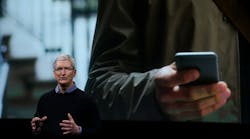Apple CEO Tim Cook kicked off a media event today designed for the introduction of new products by wading into the political debate over privacy and encryption.
At the company’s headquarters in Cupertino, Calif., Cook took the stage and immediately addressed a legal standoff with the FBI over a court order requiring it to help the U.S. unlock the handset of a terrorist who killed 14 people in San Bernardino last year. Cook said he’s humbled by the support Apple has received from Americans.
“We did not expect to be in this position, at odds with our own government, but we believe strongly we have a responsibility to help you protect your data and your privacy,” he said. “We will not shrink from this responsibility. … We need to decide as a nation how much power the government should have over our data and over our privacy.”
In a series of filings over the past month, Apple has repeatedly sought to frame the FBI debate as a potential threat to the privacy of hundreds of millions of iPhone users around the world. For its part, the U.S. Justice Department wants to keep the discussion focused on the individual handset that is the subject of the case. A judge in Riverside, Calif., will review the latest evidence on Tuesday.
During the rest of the event, Apple unveiled a new, smaller iPhone that will start at $399, seeking to jump-start sales of its flagship product by enticing more users to upgrade, especially in high-growth markets such as China and India.
The iPhone SE has a 4-inch screen, comes in four stainless-steel finishes, and incorporates the faster A9 processor that also runs the larger iPhone 6S handsets, Apple vice president Greg Joswiak said. Apple also showed off a new iPad, incorporating the power and some features of its larger Pro model for business users, and cut the price of its year-old Apple Watch.
The revamped lower-end iPhone arrives two months after Apple said that quarterly sales will probably decline for the first time since 2003, with concern mounting that demand for high-end smartphones may have reached its peak. Customers’ eagerness to freshen their handsets regularly has waned in the past two years – the company sold 30 million of the older 4-inch iPhones last year – and the updated model could encourage those holdouts to buy a new iPhone. About 37% of iPhone users have an iPhone 5S or older, according to market-research firm AppLovin Corp.
“There’s a lot of people out there who like the smaller form factor, so this is a good move,” Scott Galloway, a New York University Stern School of Business professor, told Bloomberg Television in an interview before the product announcement. “It’s evolutionary, not revolutionary.”
The iPhone SE comes with 16 or 64 gigabytes of storage, with the latter costing $499. The iPhone SE has full support for the Siri voice-enabled digital assistant, a 12-megapixel camera, and includes features found on the larger phones like Apple Pay and Touch ID. Orders for the new smartphone and iPad begin Thursday, and the phone will be shipped starting March 31. The company also showed new band styles for Apple Watch, made of woven nylon. Prices for that device will now start at $299, down from $349.
While analysts from UBS Group AG to RBC Capital Markets predict about 15 million annual shipments of Apple’s new handset, introducing the product in the spring might help bolster revenue over the summer, when sales traditionally dip. Apple sold 231 million iPhones in the last fiscal year.
Phil Schiller, Apple’s senior vice president and head of marketing, unveiled the iPad Pro with a 9.7-inch display, a smaller version of the 12.9-inch Pro tablet designed for business users that was first introduced in September. The smaller Pro will start at $599 for a 32-gigabyte model.
Apple chose to introduce a new 9.7-inch model because “it has remained our most popular size,” Schiller said. For current users, “it is their ultimate upgrade,” he said.
Revenue from the tablet, introduced in 2010, fell by 21% in the three months that ended in December, with existing users seeing no need to buy updated models and more people choosing larger phones instead. The company sold 16.1 million of the devices in the quarter, a 25% decline from the holiday quarter a year earlier.
Overall tablet shipments are forecast to decline 5.9% to 195 million units in 2016, according to market researcher IDC. Apple is projected to win 22% of the worldwide market in 2020, a decline from 29% this year, according to an IDC report earlier this month.
By Alex Webb and Brad Stone



